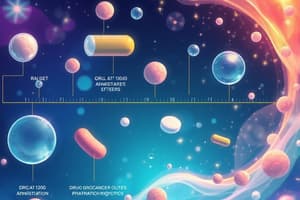Podcast
Questions and Answers
What is the main focus of pharmacokinetics?
What is the main focus of pharmacokinetics?
- The effect of the body on the drug (correct)
- The chemical structure of the drug
- The therapeutic effect of the drug
- The effect of the drug on the body
What type of transport is used for large hydrophilic medications?
What type of transport is used for large hydrophilic medications?
- Passive diffusion
- Endocytosis
- Active transport (correct)
- Facilitated diffusion
What can affect the surface area of the intestine and reduce drug absorption?
What can affect the surface area of the intestine and reduce drug absorption?
- Enteric coat
- Food intake
- Gastric emptying
- Inflammatory bowel disease (IBD) (correct)
What happens to the drug absorbed in the intestine before entering the systemic circulation?
What happens to the drug absorbed in the intestine before entering the systemic circulation?
What is the term for the process by which a drug is moved from the site of administration to the circulation?
What is the term for the process by which a drug is moved from the site of administration to the circulation?
What is the main advantage of using alternative routes of administration such as IV, IM, transdermal, sublingual, and inhalation?
What is the main advantage of using alternative routes of administration such as IV, IM, transdermal, sublingual, and inhalation?
What is the term for the movement of a medication from circulation to body tissues?
What is the term for the movement of a medication from circulation to body tissues?
What is the term for the process of converting a medication into a less or more active form?
What is the term for the process of converting a medication into a less or more active form?
What is the main reason why morphine, a weak base, is trapped in the brain?
What is the main reason why morphine, a weak base, is trapped in the brain?
Which type of drugs tend to bind to albumin?
Which type of drugs tend to bind to albumin?
Flashcards
Pharmacokinetics
Pharmacokinetics
The effect of the body on a drug, focusing on getting enough drug to the target site for a therapeutic effect.
ADME
ADME
The four main processes in pharmacokinetics: Absorption, Distribution, Metabolism, and Excretion.
Absorption
Absorption
Movement of a drug from the administration site into the bloodstream.
First-pass metabolism
First-pass metabolism
Signup and view all the flashcards
Bioavailability
Bioavailability
Signup and view all the flashcards
Distribution
Distribution
Signup and view all the flashcards
Protein binding
Protein binding
Signup and view all the flashcards
Metabolism
Metabolism
Signup and view all the flashcards
Oral Route
Oral Route
Signup and view all the flashcards
IV Route
IV Route
Signup and view all the flashcards
Study Notes
Pharmacokinetics
- Deals with the effect of the body on the drug, focusing on getting enough drug to its target site to produce a sustained therapeutic effect.
- Has 4 main domains: Absorption, Distribution, Metabolism, and Excretion (ADME).
Routes of Administration
- Oral
- IV
- Rectal
- IM
- ID
- Subcutaneous
- Sublingual
- Buccal
- Inhalation
- Topical
Absorption
- Movement of drug from site of administration to circulation.
- Passive diffusion: used for small hydrophobic medications.
- Facilitated diffusion: used for large hydrophilic medications.
- Active Transport: used for large hydrophilic medications, moving against their concentration gradient.
- Endocytosis: used for extremely large medications.
Factors Affecting Absorption
- Surface area: intestine is a prime area for absorption due to its large surface area, which can be affected by IBD and gastroenteritis.
- Enteric coat: some medications are sensitive to stomach acid and need a protective covering to avoid getting damaged.
- Gastric emptying: certain medications or health conditions can slow down the emptying of the stomach, delaying the passage of the drug into the intestine.
- Food: food can affect the absorption of medications, as seen in a study with the antibiotic cloxacillin.
First Pass Metabolism
- The drug absorbed in the intestine will be transported to the liver via the hepatic portal vein before entering the systemic circulation.
- Hepatic enzymes break down most medications into inactive metabolites and convert prodrugs into active metabolites.
Bioavailability
- The fraction of administered medication that reaches systemic circulation in its unchanged form.
Distribution
- Movement of medication from circulation to body tissues.
- Dependent on factors such as:
- Blood supply: more rapidly distributed to tissues with high blood supply, e.g. brain, kidney.
- Barriers: blood brain barrier allows small fat soluble medications compared to large water soluble medications.
- Ion Trapping: dependent on the weak base property of a medication and the acidic pH of the brain, making it impermeable to the blood brain barrier.
- Placental barrier: lipid soluble medications readily pass through the placenta and enter the fetal circulation, whereas water soluble drugs cannot.
- Protein Binding: affects the distribution of medications, with partly unbound medications being free to diffuse into the tissue and partly bound medications remaining limited to the plasma.
Protein Binding
- Partly unbound to plasma protein (or free): free to diffuse into the tissue.
- Partly bound to plasma protein: remain limited to plasma and act as a reservoir.
- Medications with low protein binding are readily distributed, while medications with high protein binding take longer to free themselves to diffuse, resulting in a longer duration of action.
- Binding to specific proteins: different medications have preferences for binding to specific blood proteins based on their chemical properties, with acidic drugs binding to albumin and basic drugs mainly binding to a1-acid glycoprotein.
Metabolism
- Process of converting a medication into a less or more active form.
- Carried out in the liver (hepatocytes).
- Phase 1: CYP450 (hepatic enzyme) deactivates the drug to produce a primary metabolite.
Studying That Suits You
Use AI to generate personalized quizzes and flashcards to suit your learning preferences.




